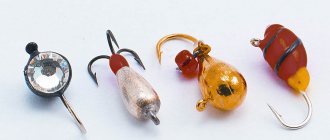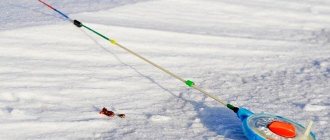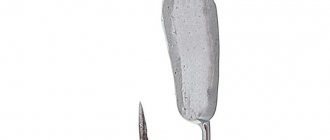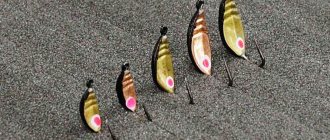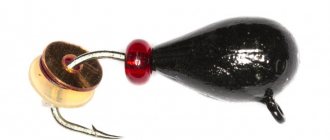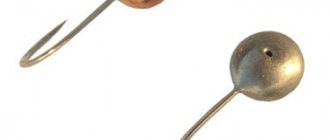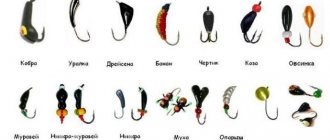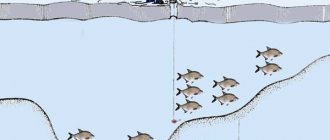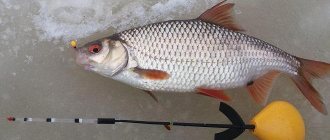Which jigs are the most catchy for winter fishing?
Mormyshka is an artificial bait used in winter due to the lack of natural bait. Tungsten is considered the best, as it has minimal dimensions and maximum possible weight. The specific gravity roughly corresponds to the weight of gold, one of the heaviest metals on earth. Homemade tungsten baits are used for fishing in fast currents and great depths.
Lures of this type have the following advantages:
- Stable behavior in fast currents and high degree of immersion.
- The bite improves, since the size of the bait corresponds to the small representatives of the underwater world that fish feed on in winter.
- High strength and durability thanks to tungsten material.
In turn, baits are divided into two types: moths and non-moths.
Moths
Moths are called bait rigs. This is a classic of winter fishing. The essence of using moths is that additional bait is placed on the hook. Most often, it is used as a bloodworm, used with a tungsten jig.
Moths are used successfully when fish activity is low. The bright ruby larvae of the dragoon mosquito look very appetizing on a hook, and cause the same excitement in predatory or peaceful fish. But moths also have disadvantages - poor preservation, tenderness and inconvenience in the nozzle.
In winter fishing, fishing with maggots mounted on tungsten tackle, instead of the usual bloodworms, has increasingly begun to be used in winter fishing. Maggot has significant advantages compared to bloodworms. It withstands frost perfectly, can be stored for a long time, fits perfectly and stays on the hook.
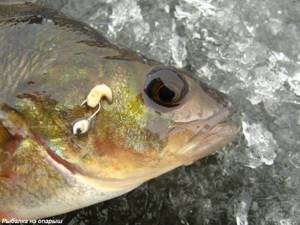
In the absence of live moths and maggots, amateur fishermen use artificial substitutes, divided into two types:
- The pellet, which has a rich range of colors, is the most popular artificial bait. This is a replacement for live bloodworms. To imitate it, pellets are placed on a hook, like beads.
- A drop is a type of pellet and has an elongated shape. Successfully used to imitate maggots.
Mothless
If there is an active bite and the fish are caught using any bait, then successful fishing is possible with the help of a reelless bait - a type of baitless tungsten tackle. Luck is achieved by skillfully playing with bait at different depths.
Tungsten reelless jigs have several popular varieties:
- Ant. The shape of the tackle resembles an ant. Used for fishing for roach or bream during the most active seasons. When fishing, you need to make small vibrations with the rod. A reelless tungsten jig will be perceived by the fish as an ant caught in the water.
- Boat. It is used for catching peaceful fish at a depth of up to 2.5 m. To attract, the active wiring technique is used. It comes in a variety of colors and additional attachments.
- Donkey. Its shape resembles a quarter of a coffee bean. Works great in a variety of conditions. In this case, the presence of a current does not matter. This type of bait is painted black and has one hook.
- Damn. Most often used for fishing for pike perch. In addition, it is successfully used for catching other types of fish. They come with three or four hooks.
- Goat. Many fishermen consider it a separate type of gear. In fact, this is a type of devil. If there are 3-4 hooks on a devil, then no more than two are used on a goat. Goat is made from copper or brass. Refractory metal is not used for its manufacture. The main application is ice fishing with the appropriate fishing technique.
- Uralka. A popular type of bait for predatory fish. Outwardly it resembles a curved drop. A classic artificial bait in the amateur fisherman's collection.
All about tungsten jigs
- VK
When it comes to tungsten jigs, most manufacturers, either intentionally or out of laziness, do not provide the buyer with complete and objective information about the specific material from which their products are made.
The fact is that in its pure “ideal” form, monolithic tungsten is one of the hardest metals with a very high density (various sources indicate from 19.2 to 19.3 g/cm), second only to several metals of the platinum group and their relatives “relatives”, which include, for example, platinum, iridium, osmium, rhenium. Thus, the theoretical density of this metal is almost equal to that of gold at a much lower cost. But this only applies to pure, almost monolithic tungsten. The key word here is “monolithic”. Because tungsten has one unique quality, which, combined with the high hardness of the crystals, makes the production of products very specific - the highest refractoriness among all known metals.
This means that the technology of melting and casting small and complex shapes from it is difficult to implement. The industry uses smelting technology in electric arc furnaces with a consumable electrode. In this case, the result is still far from a monolithic blank, but a mass consisting of fairly large crystals, which has increased fragility. This method produces blanks weighing from two hundred kilograms to three tons. It is clear that it is very difficult to use it to obtain such small forms as the bodies of jigs - for purely technical reasons.
That is why powder metallurgy technology is used so widely. Its essence in a nutshell and in simple terms boils down to the fact that metal powder is used as the initial raw material, which is filled into a certain volume, and then at high temperature and under mechanical action (pressing or forging) it is sintered into a finished product of a certain given shape. Since metals increase their plasticity with increasing heating temperature, at some point, combining a certain temperature and pressure, individual grains of metal stick together, acquiring mechanical properties comparable to those obtained with a more time-consuming and expensive casting method. In addition to purely mechanical action, causing grains of metal to adhere to each other, various more fusible and viscous metals can be used. In this case, a solid two-fraction mixture of metals is obtained - to a certain extent, particles of a harder and more refractory metal, tightly packed relative to each other, are additionally glued together with a more viscous and fusible metal.
In a similar method of manufacturing rolled tungsten, forging at high temperatures is used to impart strength, giving tungsten, which is hard and very brittle under normal conditions, significant ductility. It is clear that the resulting physical characteristics do not correspond to the standard ones even for tungsten that is used for rods and plates under the HF and EHF brands according to Soviet and Russian standards or under the WP brand in relation to welding electrodes manufactured according to international DIN standards. You can easily verify this by reading the data from the manufacturers of these materials. For example, certificates for imported WP brand electrodes indicate a density in the range from 18.3 to 18.6 units. Domestic analogues, according to the technical documentation of the manufacturers, have a density of 18.6 to 18.7 units.
It is important to note here that these are not just rods or plates of sintered powder of at least 99.9% purity. During the manufacturing process, these rods are forged at high temperatures, which for obvious reasons cannot be done when sintering jig bodies. Moreover, already at the sintering stage, holes are made in the body of the jig for fishing line and for sealing the hook. Otherwise, the workpiece will simply split or be left without holes. That is why it is impossible in practice to obtain a sintered jig with at least the actual density of factory-made pure tungsten, not to mention the ideal tungsten density of 19.2 - 19.3 g/cm - the powder simply cannot be compacted to the point of a monolithic state.
That is why in reality, sintering technology does not use “pure” tungsten powder, but a mixture of it with some metals that perform a binding function: copper, nickel, iron, and sometimes others. They are marked according to the letters of the binding metals: copper - M, nickel - N, iron - Zh. As a result, alloys with a tungsten content of 95 - 97% or less are obtained. Moreover, the heaviest mixtures are used quite rarely, because... raw materials are more expensive, and their sintering is a more expensive and capricious procedure. Manufacturers who are most serious about the performance characteristics of their products can make bait bodies with a density reaching 18.2 g/cm.
True, there is an important nuance - in the vast majority of cases, the production of tungsten bodies is located in close proximity to the global supplier of raw materials, as well as a supplier of cheap electricity and cheap labor. This, if anyone doesn’t know, is China, which is the main producer of tungsten in the world.
Chiseled tungsten, sintered tungsten
Conventionally, tungsten jigs can be divided into “turned” and “sintered”. In the first case, a certain tungsten workpiece in the form of a rod (photo 1) is processed by cutting until the desired shape is obtained.
Then, upon careful examination, we can detect traces of a cutting tool - lathe cutters or emery stone. Turning a tungsten or tungsten alloy rod allows you to make almost identical serial baits with a certain production culture and qualifications. Alas, in order to set up a machine for high-precision but serial turning of such a specific and difficult material, you need to have certain knowledge and skills that are often inaccessible to the average hired worker.
Moreover, it is rare to find “iron workers” who are capable of producing the main thing - a cutting tool of such quality that from one sharpening of a cutter several hundred prints will be obtained - the turned bodies of jigs. There are so many pitfalls here that you can unknowingly make mistakes about them for years. Especially in combination with finding out the optimal cutting mode. But a characteristic feature of turning will always be the resulting bodies of rotation - “drops”, “pellets”, “pears”, “ants”, etc. With the help of a magnifying glass, you can see traces of processing during rotation on them (photo 2).
Curved and asymmetrical bodies can be turned only with the help of very expensive equipment, which does not allow for rapid stamping of in-line products at a mere cost, or with sandpaper. The latter option can actually be equated to hand-turning, when each bait is obtained in its own shape with certain deviations from the next one.
But that's not all. There is still the problem of making a hole for the fishing line. Industrially, continuous drilling of tungsten is carried out reliably, perhaps, only on large hole diameters. And almost all the time we are talking about tungsten alloys with a noticeable content of impurities and significantly lower hardness. drilled jig bodies. And as soon as we talk about hole diameters of a few tenths of a millimeter and a material with a concentration of 98 - 99%, then in-line and cheap drilling becomes almost or completely impossible for the vast majority of manufacturers. That is why the drilled bodies of jigs (photo 3) are still produced in any significant quantities by only a few people, who can be counted on the fingers of one hand, and sports fishermen even know them by name. And other products, which are sold in many stores with the sign of turned tungsten and have a relatively large hole, are simply made of a much softer and lighter tungsten alloy - that’s the whole secret.
Sometimes you can hear or read that holes in jigs are made with an electrical discharge machine or even burned with a laser. In principle, this is possible, but in practice it is unlikely to be true.
- Firstly, both equipment is extremely expensive and does not provide any speed gain before drilling.
- Secondly, with its help it is hardly economically justifiable to make relatively cheap in-line products.
- Thirdly, the resulting hole will have extremely uneven edges and a shape that requires additional machining and adjustment.
That is why some jig manufacturers still continue to cut a wide longitudinal groove more than halfway through the body of the jig. And in this groove, after several additional operations, a hook is attached and a hole is formed for the fishing line (photo 4). It goes without saying that such a groove significantly reduces the weight of the jig. But its presence in most cases indicates the raw material used - heavy and hard tungsten, and not a light and softer tungsten alloy.
Now - about the case when the shape of the jig is given by pressing at the stage of the existence of tungsten in the form of powdered metal with an organic additive, which gives the mixture plasticity similar to plasticine. When calcined, the organic matter evaporates, and a binding relatively low-melting metal (copper, nickel, iron) holds the tungsten grains together. In this case, the dimensions shrink, and traces of the connection of two molds remain on the body, which cannot be completely hidden - the jig seems to consist of two connected halves (photo 5).
Obviously, in light of the difficulties described above in making jigs in tungsten and tungsten alloy, no one drills or burns sintered bodies. They are baked by the same so-called “Chinese rice farmer”, who in most cases does not even understand what he is doing and why IT should have the highest possible density. The result is holes of a fairly large and often variable diameter - as the material shrinks during sintering, so will it be.
The practical conclusion from this is again simple and clear. If they tell you about “the heaviest turned tungsten”, but in reality you see a soldered wide groove more than half the length of the body, then you are looking at just a reliable, but not at all the heaviest product. If you find traces of contact between two molds on the body of the jig, and at the same time you are regaled with stories about the same heavy tungsten with a density of 19.3 units, it means that you are being shamelessly deceived. And the words about expensive lasers, etc. are nothing more than dishonest advertising, calculated on the ignorance of others, because the cost of just one given operation will significantly exceed the cost of almost all the others and will increase the price of the finished product several times over - a jig on the counter will become simply uncompetitive. Therefore, a hole burned by an electroerosive or laser machine can only be found on products made using “free” equipment, when the real cost of this operation does not matter.
Sports tungsten jigs
For some time now, this concept has been firmly entrenched in the minds of many, although it is, in fact, very controversial. The fact is that in practice the division is not into “sports” and “amateur” in terms of application, but only in terms of quality and approach to the manufacture of baits. In sports, due to its specificity, they try to take into account every little detail, get rid of the slightest shortcomings, and achieve at least a small advantage.
Therefore, the approach to jigs that athletes choose is much more serious than that of amateur fishermen. Here you need maximum mass with a minimum size (this means the most stringent requirements for the material and tools for processing it). Maximum precision in manufacturing a series of jigs is also required to achieve their interchangeability. This is what actually defines technology. Almost all so-called “sports jigs” (photo 6) are made by turning tungsten followed by drilling, and not at all by sintering a lighter tungsten alloy.
Those craftsmen who still sharpen jigs with a file, holding the rod in a drill or in a drill chuck mounted on the shaft of an electric motor, and then cut a groove for the hook and a hole for the fishing line, do not do this because it is more profitable from the point of view of the end use . It’s just that, for a variety of reasons, they do not have the opportunity to manufacture their products on more specialized equipment with greater accuracy.
Strength of galvanic coating
Now we have gradually approached the issue of applying galvanic coating to the surface of the tungsten jig and its strength and durability, which directly affect the reliability of the hook installation. Electroplating, as the application of metal coatings by the galvanic method is called for simplicity, has been covering jigs since Soviet times. And I remember from the first years of using such jigs one requirement - to treat this thin film of metal on the surface of the bait with extreme care and precision. The fact is that a violation of its integrity (photo 7) near even a fairly large groove, which has a significant area of adhesion between the surfaces of the coating and the body of the bait, a little earlier or a little later led to the hook falling out along with the solder.
And even the galvanization applied on factory equipment using industrial reagents simply peeled off. These are the features of this technology, which is clearly inferior to the more reliable, but many times more labor-intensive technology of soldering tungsten with refractory copper and silver solders. It is the labor intensity and resulting high cost of soldering using a torch with copper solder that does not allow making such products in-line.
The greatest limitations on the adhesion strength of the galvanic film to the body of the jig appear on drilled jigs. There are two factors at play here: a very small adhesion area, as well as a cylindrical surface. In total, this leads to the fact that in practice, almost any galvanized jig can be deprived of a hook as a result of its “strength test,” which is sometimes practiced - the body of the jig is tightly clamped with the fingers, and an attempt is made to rotate the hook around the axis of the fore-end. And after applying more or less effort, the hook turns out to be unscrewed and with a cylinder of solder and a film of galvanic coating sitting on it.
Related articles:
Winter sparkle
Review of homemade tungsten jigs
Which balancer to choose
Catching smelt from ice
What are tungsten jigs?
A tungsten jig consists of a fishing hook and a weight made of high-density metal. It is easy to find in fishing stores. But there is one important drawback - the high price. Therefore, this gear is often purchased for sport fishing.

Knowing the advantages of combining large weight with small size, fishing enthusiasts have mastered the production of tungsten jigs at home. Many fishermen have achieved such skill that homemade baits are superior in catchability to industrial models. To make cheap tungsten jigs, all you need is patience and a simple set of tools and materials.
Under what conditions are they most effective?
The greatest effect from the use of tungsten jigs is obtained during winter fishing. In winter, the fish behaves passively, hunting for miniature underwater objects. This tackle is great for catching capricious and sluggishly biting fish.
In addition, tungsten jigs of the Diskus brand, manufactured by Diskus, weigh twice as much as lead, with small dimensions. This allows for effective fishing at great depths and fast currents.
Dimensions
Gear has a gradation of sizes, depending on the fishing season and the type of fish. The ball size of a tungsten jig is 2-6 mm for catching perch in winter.
Homemade tungsten jigs for pike perch fishing have an oblong shape and the largest size among winter gear, and are painted white.
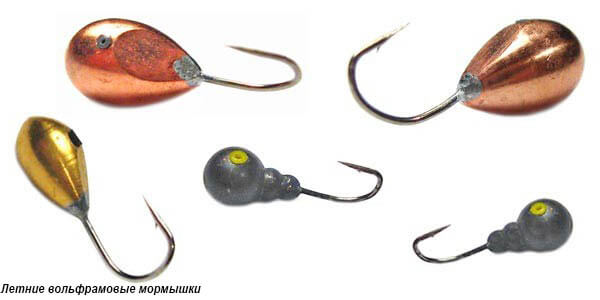
The largest, compared to winter gear, are summer tungsten jigs in the form of drops. The droplet sizes vary: in diameter from 3 to 5 mm, in height from 8.5 to 9.5 mm. In the warm season, the drop turns red-brown, and pike perch, perch, and crucian carp bite well on it.
Weight
By weight category, gear is divided into light, medium and heavy. When making a tungsten jig with your own hands, on average, they adhere to weight gradations of 0.7 g, 0.85 g and 1.8 g.
The weight of the tungsten jig is selected for specific tasks. It depends on the strength of the current and the depth of the reservoir. The deeper the reservoir and the more intense the water flow, the more weight the bait should have.
Why are jigs made of tungsten? Due to their high specific gravity, baits have significantly smaller dimensions compared to lead baits. As a result, the flow of the current has less influence on the action of the bait, small sizes are more natural and attractive to fish.
Design Features
In addition to ordinary baits, the range of products now includes elite tungsten carpe diem jigs. They have a flattened olive-shaped shape with a gold coating. The equipment allows the installation of a fluorescent pellet, which makes biting a particularly exciting activity.
What kind of fish are caught?
In summer, a jig made with your own hands from a tungsten electrode is good for catching pike perch, roach, crucian carp, and perch. The color of the artificial bait is important here. Red-brown shades are preferred. In winter, bait is used to catch crucian carp, perch, and carp.

DIY tackle
Experienced fishermen prefer to make tungsten tackle with their own hands. This process is creative and requires perseverance and patience, but the result is worth it.
Many fishermen say that a hand-made jig has special energy and brings good luck.
Those who decide to test this statement and make such a lucky bait will need:
- soldering iron with a thin tip,
- tweezers,
- tungsten soldering flux,
- solder,
- soldering acid,
- pliers,
- electric sharpener,
- tungsten electrode about 4 mm in diameter,
- diamond files.
All this is necessary for precise and almost jewelry-like work on creating a jig and will be useful in the future if your hobby is fishing.
Stages of work
Having prepared the necessary tools, you can get to work. All the skills acquired in labor lessons at school will come in handy here. The main thing is patience and accuracy. The sequence of actions is as follows:
- The part necessary for the manufacture of a certain type of jig is cut off from the electrode. The choice is arbitrary, depending on the purpose of the gear. It could be: the shape of a drop, a banana, an ant or a fly.
- The turned product is processed with a needle file to eliminate irregularities.
- The workpiece is heated red-hot, then dipped into solder. After it has been tinned, it is necessary to remove solder deposits using a needle file.
- The hook also needs to be tinned, and then carefully soldered to the tungsten blank.
- The finished tackle is cleaned of all possible contaminants and then painted with regular nail polish.
The beauty of homemade tungsten jigs is that you can experiment. They can be made large or very tiny, using beads and seed beads or without them at all. A hook is a base on which you can attach: beads, pieces of colored tubes, a pendant in the form of a chain and other little things. The hook can also be suspended - it is easily swallowed by fish and has proven itself well.
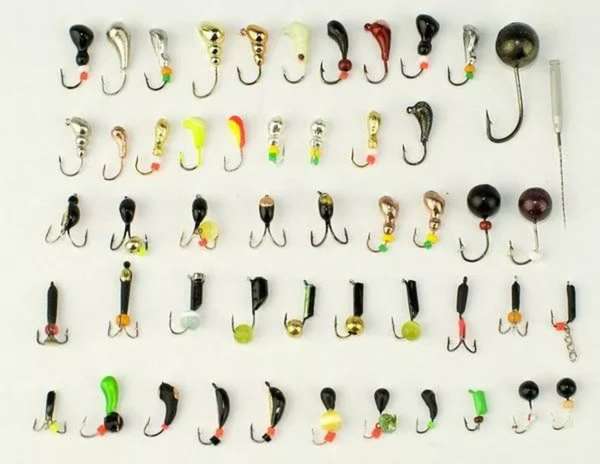
For a long hook shank, you can use a crimp tube - a cambric. A hook is threaded through it and heated with a hairdryer or candle flame. After heating, the tube tightly grips the metal and will last a long time .
How to make a tungsten jig with your own hands
You can easily make tungsten jigs with your own hands using the following technology:
- Cut off a fragment corresponding to the shank of the hook from the tungsten electrode.
- Cut the heat shrink tubing slightly longer than the insert.
- The rod and shank of the fishing hook are inserted into the heat-shrinkable plastic tube.
- In the flame of a candle or lighter, heat-shrink and compress the assembled structure.
- Apply a layer of superglue along the edges of the tube.
The result of production is a tungsten jig, quite durable, which can be used in both reel and non-reel versions.
Materials and tools
Making tungsten jigs with your own hands requires equipment with the appropriate materials and tools:
- tungsten electrode;
- fishing hook;
- plastic heat-shrinkable tube SSD;
- lighter;
- a grinding machine with a cutting disc for cutting the electrode;
- Super glue;
- protective glasses;
- bench vice;
- thin disk with diamond coating;
- set of files.
Where can I get tungsten for equipment?
Tungsten is a widely used material. The refractory metal is used in incandescent light bulbs and is sold in the form of wire. In addition, tungsten for jigs can be found in workshops engaged in argon welding. Refractory welding electrodes are suitable for the manufacture of tungsten jigs.
The simplest technology for soldering a tungsten jig
To begin with, you need to cut the material to the desired size on a cutting or grinding wheel. In this case, you should protect your eyes with glasses. Then hold it in a vice and drill a hole in the tungsten blank with a drill with a diameter of 0.7-1.5 mm. Drill at 500 rpm using emulsion. Any oil is suitable as an emulsion - from vegetable to machine oil. Some even use milk.

Soldering tungsten is a serious problem because it cannot be soldered with tin-lead solder. There are many videos on the Internet showing the intricacies of the technology, how to solder tungsten bait. They describe two soldering methods:
- copper plating by electrolytic method followed by soldering the hook with tin-lead solder;
- dipping a red-hot workpiece into hard solder of the PSR type, using a specialized flux, followed by soldering with hard or tin-lead solder.
Before soldering tungsten jigs at home, cut the groove for the hook with a thin diamond-coated disk. Insert nichrome, or better yet, tungsten wire into the drilled hole to prevent soldering.
What to consider when making
It is necessary to take into account many nuances of the technological process. The main problem is the frequent breakage of the fishing line due to the sharp edges of the hole in the tackle.
How to make a tungsten jig and avoid loss.
To avoid unnecessary losses, they use a method such as inserting a plastic cambric into the hole of a tungsten jig.
In addition, it is necessary to avoid overheating when soldering the copper-plated layer of a tungsten bar to prevent peeling.
How to tie tungsten jigs correctly
Three categories of knots have been developed for how to properly tie a jig with an eye:
- Rigid tightening knots covering the ring with strong fixation. Recommended for use on thin lines.
- Loop knots that slide freely along the line loop are used on reelless gear.
- Hook knots, which are a compromise between loops and rigid knots. The strength is higher than on a loop, but lower than a rigid knot. Similar units are also used for attaching jigs without loops, with a hole.
